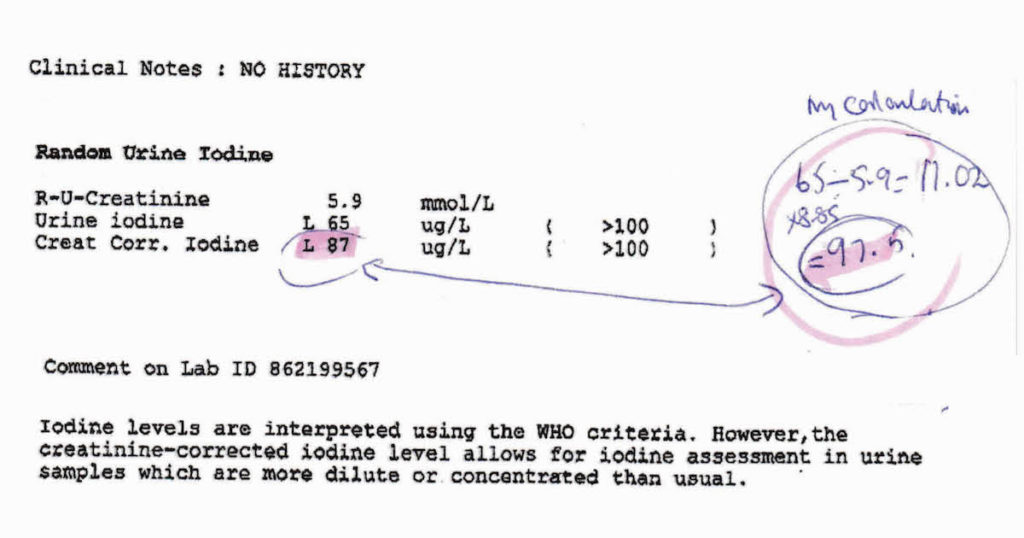Example 1:
Example 2:

We love hearing from our fellow fearless friends on the frontline – working with lab results & pathology providers – everyday. We recently received an SOS! from the Francesca Naish over yet another iodine assessment issue that you may need to also be alert to:
“Ever since you first drew our attention to the need to correct urinary iodine results, I have used your formula for all my patients’ results. Thank you for this. As most GPs don’t seem to be aware of the need to do this, I find it essential to warn my patients to wait for my interpretation before acting on their doctor’s advice! For a while now, Laverty have started giving the corrected result, which complies with the calculation you recommended. However, very recently Douglass Hanly Moir have started to give a corrected result on their result sheets, but it does not tally with the calculation I have been using (the one you recommended) and generally gives a lower figure.”
Well, as always, cluey people ask cluey questions…and this did take some back & forth with DHM to solve. Increasingly, all the major pathology companies are coming around to the essentiality of urinary iodine correction, something I’ve been banging the drum 🥁 about now for….yikes…7 years..no wonder I’m going grey! This is a mathematical formula applied to any raw score for urinary iodine to account for the dilution/concentration of the given sample, because, as we all know, hydration status varies widely between individuals and even within an individual at different times – and this is something that can wildly lead you astray in your thoughts about their iodine status, if not accounted for. Some companies are now employing the formula we use: Iodine (mcg) ÷ Creatinine (mmol) X 8.85 = Corrected Iodine in mcg/gCr which is wonderful to see. But DHM have taken a different path, strangely enough, using this formula BUT rather than using the patient’s own reported urinary creatinine they instead use a ‘median creatinine’
Which…I am going to say it… MAKES NO SENSE!^%@* aka we WILL correct this iodine for hydration status – but we’ll correct it for someone else’s no yours! – Ms/Mr average…ok?
Ahhhh no.
Just look at the difference this makes in a patient with very dilute urine, in example number 2 above!!
So Francesca & all of you on the frontline, can be assured, if you’re using the formula above – it is correct – keep up the great work and know that it is often better to do something yourself than blindly trust a 3rd party when it comes to pathology…unless that 3rd party is our RAN Patient Pathology Manager template which calculates this perfectly of course!
Increasingly our patients are coming armed with lab results and this cumulative data helps us to clearly see their ‘norms’ (as opposed to textbook ones) and therefore be alert to any changes. However, results from different labs at different times, and even the same lab, are unlikely to be presented side by side for easy comparison. They certainly don’t come with all the important information about what was happening for that patient at each time point – important details pertaining to the blood collection itself (fasting, inflamed etc) which can profoundly alter results or the broader context: menstruating, breastfeeding, losing weight, on meds and supplements.
The Patient Pathology Manager retains all the results for you, including the critical contextual elements, helping you to keep more accurate records to make the most correct interpretation. It also assists you to monitor changes related to various interventions.
Previously, the RAN Patient Pathology Manager has only ever been available to clinicians who participate in Group Mentoring but due to frequent requests for access, we thought it was time to share this great tool for those wanting a foot up with some better systems in their practice.
This provides you with a template that can be used an infinite number of times plus a short training tutorial.
